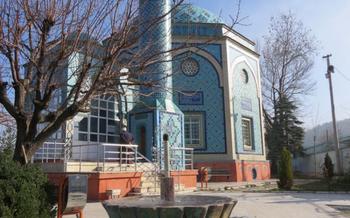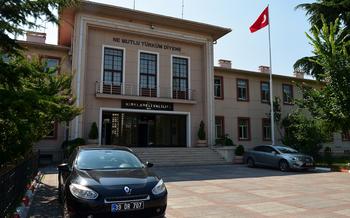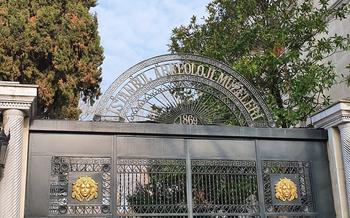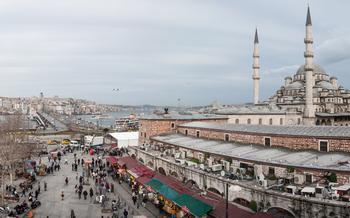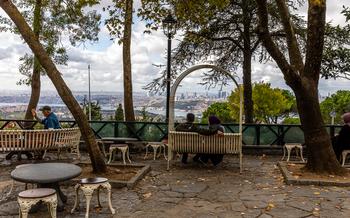
Kütahya Porcelain Museum
- Unveiling the History of Kütahya Porcelain
- A Journey Through the Museum's Galleries
- Masterpieces of Turkish Ceramic Art:
- Cultural Significance of Kütahya Porcelain
- Hands-On Experience: Ceramic Workshops and Classes
- Shopping for Ceramics in Kütahya
- The Legacy of Kütahya's Ceramic Artisans
- Kütahya's Ceramic Festival: A Celebration of Craftsmanship
- Exploring Kütahya's Ceramic District
- Historical Context of Kütahya's Ceramics
- Ceramic Techniques and Styles in Kütahya
- Contemporary Ceramic Art in Kütahya
- The Future of Kütahya's Ceramic Industry:
- Insider Tip: Discovering Hidden Ceramic Gems
Unveiling the History of Kütahya Porcelain
Kütahya's porcelain industry boasts a rich and storied history, dating back to the 16th century when the city became a significant center for ceramic production. The origins of Kütahya porcelain can be traced to the migration of skilled potters from the Middle East, who brought with them their knowledge and expertise in ceramic art.
Over time, Kütahya's porcelain industry flourished, thanks to the city's strategic location on trade routes and the abundance of high-quality clay in the region. Porcelain production techniques evolved and refined, influenced by various cultural and artistic traditions, including Islamic, Ottoman, and European styles.
Ceramics held a significant socio-cultural position in Turkish society, serving both functional and decorative purposes. They were used in everyday life, from tableware to decorative tiles, and played a vital role in religious and ceremonial contexts. Kütahya porcelain, with its exquisite craftsmanship and artistic value, became a symbol of Turkish art and culture, showcasing the country's rich heritage and creativity.
A Journey Through the Museum's Galleries
The Kütahya Porcelain Museum houses a diverse collection of ceramic artifacts, showcasing the evolution of Kütahya's porcelain industry from its early beginnings to the present day. The museum's galleries are thematically arranged, providing visitors with a comprehensive understanding of Turkish ceramic art and its significance.
One of the highlights of the museum is the Ottoman Ceramics Gallery, which features a stunning array of ceramics from the Ottoman period. Here, visitors can admire intricate tilework, decorative plates, and monumental vessels that exemplify the artistic achievements of the era. The gallery also showcases a selection of Kütahya's renowned calligraphic ceramics, renowned for their elegant script and vibrant colors.
Another must-see section of the museum is the Contemporary Ceramics Gallery, which showcases the works of contemporary Turkish ceramicists. This gallery offers a glimpse into the innovative and experimental approaches of modern artists who are pushing the boundaries of ceramic art. Visitors can find a diverse range of pieces, from abstract sculptures to functional ware, showcasing the vitality and creativity of contemporary Turkish ceramics.
The museum's Interactive Gallery provides a hands-on experience for visitors, allowing them to engage with the ceramic-making process. Visitors can try their hand at molding clay, glazing, and even firing their own ceramic pieces. This interactive section is particularly popular with families and children, offering a fun and educational way to learn about ceramics.
The Kütahya Porcelain Museum also offers guided tours, led by knowledgeable docents who provide insights into the history, techniques, and significance of the museum's collection. These tours are highly recommended for visitors who want to delve deeper into the world of Turkish ceramics and gain a deeper appreciation for the artistry and craftsmanship on display.
Masterpieces of Turkish Ceramic Art:
The Kütahya Porcelain Museum houses a treasure trove of ceramic masterpieces that showcase the exceptional craftsmanship and artistic prowess of Turkish ceramicists. Among the most notable exhibits is the "Blue Mosque Plate", an exquisite piece that captures the essence of Ottoman architecture. Its intricate blue and white patterns, inspired by the iconic Iznik tiles, pay homage to the grandeur of the Blue Mosque in Istanbul.
Another highlight of the museum's collection is the "Dancing Dervish Figurine". This ceramic sculpture encapsulates the mesmerizing movements of the Whirling Dervishes, a mystical Sufi order. The figurine's fluid lines and expressive posture convey the spiritual ecstasy of the dance, making it a true work of art.
"The Anatolian Carpet" is another masterpiece that showcases the fusion of traditional motifs and contemporary design. This ceramic piece features intricate patterns inspired by Anatolian carpets, rendered in a striking combination of colors and textures. The result is a visually captivating work that celebrates the rich cultural heritage of Turkey.
These masterpieces, along with many others, offer a glimpse into the extraordinary skill and creativity of Turkish ceramicists. They represent a testament to the enduring legacy of Kütahya's porcelain tradition and its significant contribution to the world of ceramic art.
Cultural Significance of Kütahya Porcelain
Ceramics in Turkey holds a deep cultural significance, transcending mere objects of utility. In Turkish daily life, ceramics play a vital role, serving as a testament to the country's rich traditions and craftsmanship. They are not just functional items but also symbols of Turkish hospitality and warmth, often used to welcome guests and adorn homes. The intricate patterns and vibrant colors of Turkish ceramics reflect the country's diverse cultural heritage, drawing inspiration from various civilizations that have graced Anatolian lands.
In religious and ceremonial contexts, ceramics hold a special place. Mosques and other religious buildings are adorned with ceramic tiles, featuring intricate calligraphy and geometric designs, creating a sacred and awe-inspiring atmosphere. Ceramics are also used in traditional Turkish ceremonies, such as weddings and circumcisions, as decorative elements and gifts, symbolizing joy, prosperity, and good fortune.
The preservation of cultural heritage through ceramics is of paramount importance in Turkey. Ceramics serve as tangible links to the past, connecting contemporary society with its ancestors and their artistic expressions. Ceramic museums, such as the Kütahya Porcelain Museum, play a crucial role in safeguarding and showcasing these precious artifacts, ensuring their legacy endures for generations to come.
Hands-On Experience: Ceramic Workshops and Classes
Kütahya offers visitors a unique opportunity to immerse themselves in the art of ceramics through hands-on workshops and classes. These workshops provide a comprehensive introduction to the ceramic-making process, allowing participants to experience the joy of creating their own ceramic pieces.
Under the guidance of skilled instructors, visitors can learn the basics of ceramics, including molding, glazing, and firing. The workshops cover various techniques, from traditional hand-building methods to the use of pottery wheels. Participants are encouraged to experiment with different clays, glazes, and decorative techniques to create unique and personalized ceramic pieces.
The workshops cater to all skill levels, from beginners with no prior experience to those seeking to refine their existing skills. Classes are typically small, ensuring that each participant receives personalized attention and guidance from the instructor. The workshops provide a supportive and creative environment where participants can learn, experiment, and express their artistic vision through the medium of clay.
Whether you're a seasoned ceramicist or a complete novice, participating in a ceramic workshop in Kütahya is an enriching and rewarding experience. It offers a deeper understanding of the art form, allows for creative expression, and creates lasting memories of your time in this historic city.
Shopping for Ceramics in Kütahya
Kütahya is a shopper's paradise for those seeking authentic and high-quality ceramics. The city is home to numerous ceramic shops, workshops, and galleries, each offering a diverse range of ceramic items to suit every taste and budget. Whether you are looking for traditional or contemporary pieces, functional or decorative items, you are sure to find something special in Kütahya.
To ensure you get the best value for your money, visit the Çiniciler Çarşısı, or Ceramic Bazaar, located in the heart of the city. This vibrant market is lined with stalls and shops selling a wide variety of ceramics, from traditional hand-painted plates and bowls to modern ceramic sculptures and home décor items. Be prepared to bargain, as haggling is a common practice in Turkish markets.
When shopping for ceramics in Kütahya, look for pieces that are well-crafted and have intricate designs. Pay attention to the glaze, which should be smooth and free of any cracks or bubbles. The weight and thickness of the ceramic piece are also important factors to consider, as heavier and thicker pieces are generally more durable.
Some of the unique ceramic items to look out for as souvenirs include the iconic Kütahya tiles, which are often decorated with intricate floral or geometric patterns. You might also find interesting ceramic jewelry, such as necklaces, bracelets, and earrings, that are both stylish and unique.
To ensure you are getting genuine Kütahya ceramics, look for the "Kütahya Seramiği" stamp, which guarantees the authenticity and quality of the product. With a little bit of knowledge and bargaining skills, you are sure to find some beautiful and unique ceramic pieces to take home as a reminder of your visit to Kütahya.
The Legacy of Kütahya's Ceramic Artisans
Recognition and Awards: Kütahya's ceramic artisans have garnered widespread recognition and accolades for their exceptional craftsmanship. Numerous awards and honors have been bestowed upon them, both nationally and internationally. These accolades serve as a testament to the skill and dedication of these talented individuals, solidifying Kütahya's reputation as a renowned center of ceramic art.
Preserving Traditional Techniques: The preservation of traditional ceramic techniques holds immense importance in Kütahya. Ceramicists tirelessly work to safeguard the heritage and authenticity of their craft, ensuring that these techniques are passed down to future generations. Workshops and apprenticeship programs play a crucial role in this endeavor, providing a platform for young artisans to learn and master the skills of their predecessors.
Challenges Faced by Contemporary Artisans: Despite the remarkable achievements of Kütahya's ceramic artisans, they face various challenges in the contemporary era. Economic fluctuations, globalization, and changing consumer preferences can impact the demand for traditional ceramics. Artisans must adapt to these changing circumstances while remaining true to their artistic vision and preserving the integrity of their craft.
Promoting Traditional Ceramics: To address these challenges and ensure the sustainability of Kütahya's ceramic industry, concerted efforts are being made to promote traditional ceramics on both national and international platforms. Exhibitions, workshops, and cultural events play a vital role in raising awareness, showcasing the artistry and uniqueness of Kütahya ceramics, and fostering appreciation for this cherished cultural heritage.
Kütahya's Ceramic Festival: A Celebration of Craftsmanship
Kütahya's annual Ceramic Festival is a vibrant celebration of the city's rich ceramic heritage. Held annually, the festival attracts ceramic enthusiasts, artists, and visitors from around the world. Over several days, the city transforms into a hub of creativity and artistry, showcasing the diverse talents of local ceramicists.
Highlights of the festival include exhibitions showcasing the works of renowned ceramic artists, live demonstrations where visitors can witness the intricate process of creating ceramic pieces, and hands-on workshops that provide an opportunity to try their hand at the craft. The festival also features cultural performances, traditional music, and local cuisine, creating a festive atmosphere that immerses visitors in the vibrant cultural traditions of Kütahya.
One of the most significant aspects of the festival is the opportunity for visitors to interact with ceramic artists directly. Attendees can engage in conversations, learn about the creative process, and gain insights into the techniques and inspirations behind the beautiful ceramic pieces on display. This interaction fosters a deeper appreciation for the artistry and skill involved in creating these unique works of art.
The Kütahya Ceramic Festival plays a crucial role in promoting Turkish ceramic art on a global scale. By showcasing the diverse talents of local artisans and providing a platform for cultural exchange, the festival contributes to the preservation and promotion of this ancient art form, ensuring that the legacy of Kütahya's ceramics continues to thrive for generations to come.
Exploring Kütahya's Ceramic District
At the heart of Kütahya's ceramic legacy lies its vibrant ceramic district, a hub of creativity and craftsmanship. Wander through the narrow streets, and you'll be greeted by the gentle hum of pottery wheels and the tantalizing aroma of kilns. Workshops, studios, and galleries line the district, each a testament to the city's enduring love for ceramics.
In these workshops, you'll witness ceramic artisans meticulously shaping clay into exquisite forms, their hands moving in a rhythmic dance. Observe the transformation of ordinary clay into intricate pieces of art, each imbued with the artisan's unique touch.
Don't miss the opportunity to visit local ceramic markets, where you can browse a vast array of ceramic ware. From traditional pottery to contemporary designs, there's something to suit every taste and budget. Haggle with the friendly vendors, and you might just score a one-of-a-kind piece to cherish as a reminder of your time in Kütahya.
Historical Context of Kütahya's Ceramics
Kütahya's strategic location on the historic trade routes between the East and the West played a pivotal role in the development of its ceramic industry. The city served as a melting pot of cultures and artistic influences, with merchants and artisans from diverse regions converging to exchange goods and ideas. This cross-cultural pollination contributed to the emergence of a unique style of ceramics in Kütahya, blending elements from Islamic, Byzantine, and Ottoman traditions.
Kütahya's ceramic industry flourished during the Ottoman period, becoming renowned throughout the empire for its high-quality pottery and tiles. The city's craftsmen mastered the art of glazed ceramics, using sophisticated techniques to create intricate designs and vibrant colors. Kütahya ceramics became an essential element of Ottoman architecture, adorning the walls of mosques, palaces, and other monumental buildings.
The city's ceramic industry also benefited from the patronage of the Ottoman sultans, who commissioned ceramic pieces for their palaces and as gifts for foreign dignitaries. This patronage not only provided economic support to the industry but also elevated the status of Kütahya ceramics, making it a symbol of imperial power and prestige.
Today, Kütahya's ceramic industry continues to thrive, drawing inspiration from its rich history and cultural heritage. Contemporary ceramic artists in the city are pushing the boundaries of traditional techniques, creating innovative and modern works of art that reflect the city's vibrant artistic spirit.
Ceramic Techniques and Styles in Kütahya
Kütahya's ceramic artisans employ a diverse range of techniques to create their exquisite works of art. Hand-building, a traditional method, involves shaping clay into desired forms without the use of a potter's wheel. This technique allows for intricate details and unique textures. Wheel throwing, on the other hand, utilizes a rotating wheel to shape clay, resulting in symmetrical and uniform pieces.
The decoration of Kütahya ceramics is equally diverse. Glazing, a process of applying a thin layer of glass to the surface of the ceramic, adds color, shine, and protection. Underglaze painting involves applying pigments to the clay before glazing, resulting in vibrant and long-lasting designs. Overglaze painting adds color and patterns to the glazed surface, creating a distinct aesthetic.
Traditional motifs and patterns are commonly found in Kütahya ceramics, reflecting the city's rich cultural heritage. Geometric patterns, floral motifs, and calligraphy are frequently used, often inspired by Islamic and Ottoman art. The use of color is vibrant and varied, ranging from deep blues and greens to warm reds and oranges.
Kütahya ceramics also showcase a variety of styles, from traditional to contemporary. Traditional styles often feature intricate patterns and motifs, while contemporary styles embrace more modern and abstract designs. Some notable styles include Çini, a type of glazed ceramic tile, and Sgraffito, a technique that involves scratching or carving designs into the clay surface before glazing.
Contemporary Ceramic Art in Kütahya
In recent years, Kütahya has witnessed the emergence of a vibrant community of contemporary ceramic artists who are pushing the boundaries of the traditional craft. These artists are blending traditional techniques with modern aesthetics, creating innovative and thought-provoking works of art.
Contemporary ceramic artists in Kütahya are experimenting with new forms, textures, and glazes, creating pieces that are both visually stunning and conceptually challenging. They are drawing inspiration from a wide range of sources, including traditional Turkish motifs, contemporary art movements, and personal experiences.
One of the most prominent contemporary ceramic artists in Kütahya is Mehmet Güleryüz, whose work has been exhibited in galleries and museums around the world. Güleryüz is known for his intricate and delicate porcelain sculptures, which often explore themes of nature, identity, and memory.
Another notable contemporary ceramic artist from Kütahya is Aylin Tektaş, whose work is characterized by its bold colors and geometric forms. Tektaş often uses ceramics to create large-scale installations that explore the relationship between art and architecture.
These contemporary ceramic artists are playing a vital role in shaping the future of Kütahya's ceramic industry. Their work is helping to attract a new generation of visitors to the city and is ensuring that Kütahya's ceramic tradition remains relevant and vibrant in the 21st century.
The Future of Kütahya's Ceramic Industry:
The future of Kütahya's ceramic industry holds both challenges and opportunities. The industry faces competition from mass-produced ceramics and the challenges of globalization. However, there is also a growing appreciation for handmade ceramics and a recognition of the unique cultural heritage of Kütahya ceramics.
Preservation and Promotion:
Preserving and promoting Kütahya ceramics globally is essential for the industry's sustainability. Initiatives such as the Kütahya Ceramic Festival, workshops, and exhibitions play a vital role in raising awareness and showcasing the artistry of Kütahya ceramics to a wider audience.
Technology and Innovation:
Technology and innovation can also contribute to the industry's development. The use of digital design tools and modern production techniques can help ceramic artisans create innovative designs while maintaining the traditional essence of their craft.
Sustainability:
Sustainability is another important consideration for the future of the ceramic industry. Efforts are being made to reduce the environmental impact of ceramic production, such as using eco-friendly materials and implementing energy-efficient processes.
Conclusion:
The future of Kütahya's ceramic industry is bright, thanks to the dedication of skilled artisans, the support of government initiatives, and the growing appreciation for handmade ceramics. By embracing innovation, promoting cultural heritage, and ensuring sustainability, the industry can continue to thrive and captivate the world with its unique creations.
Insider Tip: Discovering Hidden Ceramic Gems
Beyond the renowned attractions, Kütahya's ceramic scene holds hidden treasures waiting to be discovered. Venture off the beaten path to uncover unique workshops tucked away in charming alleys or nestled amidst the bustling markets. These lesser-known artisans often create exquisite pieces that reflect their personal styles and techniques, offering a glimpse into the diverse world of Kütahya ceramics.
Seek out the workshop of Master Ceramist Mehmet Usta, renowned for his intricate hand-painted designs that draw inspiration from traditional Turkish motifs. His passion for the craft shines through in every piece he creates, making his ceramics highly sought after by collectors.
Another hidden gem is the studio of Aylin Hanım, a young ceramicist who fuses traditional techniques with contemporary aesthetics. Her whimsical creations, often featuring vibrant colors and unconventional shapes, have gained recognition both locally and internationally.
To truly immerse yourself in the local ceramic culture, visit Kütahya during the annual Ceramic Festival. This vibrant event showcases the works of established and emerging ceramic artists, providing a unique opportunity to interact with them, witness live demonstrations, and purchase one-of-a-kind pieces directly from the makers.


